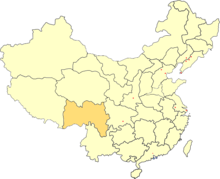| Xikang Province 西康省 | |||||||||||
|---|---|---|---|---|---|---|---|---|---|---|---|
| 1939–1950 | |||||||||||
 Xikang Province in the Republic of China | |||||||||||
| Capital | Kangding (1912–1931) Ba'an (1931–1935) Ya'an (1935–1936) Kangding (1935–1949) Xichang (1949–1950) | ||||||||||
| Area | |||||||||||
• Estimate | 451,521 km2 (174,333 sq mi) | ||||||||||
| Population | |||||||||||
• Estimate | 1,748,458 | ||||||||||
| Historical era | 20th century | ||||||||||
• Established | 1939 | ||||||||||
• Fall of Xichang | 27 March 1950 | ||||||||||
• Disestablished | 1950 | ||||||||||
| |||||||||||
| Today part of | China India | ||||||||||
| Xikang Province 西康省 | |||||||||||
|---|---|---|---|---|---|---|---|---|---|---|---|
| 1950–1955 | |||||||||||
 Xikang Province (orange) in the People's Republic of China | |||||||||||
| Capital | Kangding (1950–1951) Ya'an (1951–1955) | ||||||||||
| Area | |||||||||||
• 1953 | 451,521 km2 (174,333 sq mi) | ||||||||||
| Population | |||||||||||
• 1953 | 3,381,064 | ||||||||||
| Historical era | 20th century | ||||||||||
• Established | 1950 | ||||||||||
• Disestablished | 1955 | ||||||||||
| |||||||||||
| Today part of | China India | ||||||||||
Xikang (formerly romanized as Sikang or Hsikang, lit. 'Kham-in-the-West' or 'Kham to the west [of Sichuan]') was a nominal province[1] formed by the Republic of China in 1939 on the initiative of prominent Sichuan warlord Liu Wenhui[2] and retained by the early People's Republic of China. The former territory of Xikang is now divided between the Tibet Autonomous Region and Sichuan province.
The idea behind Xikang province was to form a single unified province for the entire Kham region under direct Chinese administration, in effect annexing the western Kham region that was then under Tibetan control. Kham was entirely populated by Tibetan people called Khampas. The then-independent Tibet controlled the portion of Kham west of the Upper Yangtze River.[3] The nominal Xikang province also included in the south the Assam Himalayan region (Arunachal Pradesh) that Tibet had recognised as a part of British India by the 1914 McMahon Line agreement.[4] The eastern part of the province was inhabited by a number of different ethnic groups, such as Han Chinese, Yi, Qiang people and Tibetan, then known as Chuanbian (川邊), a special administrative region of the Republic of China. In 1939, it became the new Xikang province with the additional territories belonging to Tibetan and British control added in. After the People's Republic of China invaded and occupied Tibet, the earlier nationalist imagination of Xikang came to fruition.
The provincial capital of Xikang was Kangding from 1939 to 1951 and Ya'an from 1951 to 1955. The province had a population of 3.4 million in 1954.[5]
- ^ Lin, Boundary, sovereignty and imagination (2004), p. 30: "Despite its almost entirely illusory nature, the so-called Xikang province was officially sketched out by Chinese map-makers, from whom it came to be known nation-wide.
- ^ Yajun Mo, "The New Frontier: Zhuang Xueben and Xikang Province", in "Chinese History in Geographical Perspective", edited by Yongtao Du and Jeff Kyong-McClain, p. 124, Lexington Books, 2013
- ^ Lin, Boundary, sovereignty and imagination (2004), p. 29: "According to the Kuomintang, the boundary of this new Xikang province encompassed, not only part of the southwestern province of Sichuan that was then dominated by the Han Chinese warlord Liu Wenhui, but also a huge portion of the ethnographic Tibetan area west of the Upper Yangtze River that was then effectively administered by the autonomous Tibetan government."
- ^ Lin, Boundary, sovereignty and imagination (2004), p. 29: "In addition, the newly carved provincial boundary also extended deep into the Tibetan-Assam tribal territory, including areas south of the theoretically existing McMahon Line that had been signed away to British India by Lhasa in 1914."
- ^ "第一次全国人口普查公报". Archived from the original on August 5, 2009. Retrieved November 17, 2009.